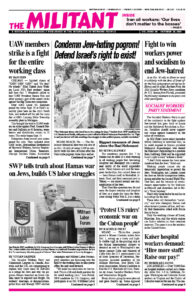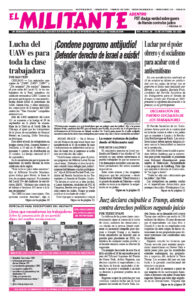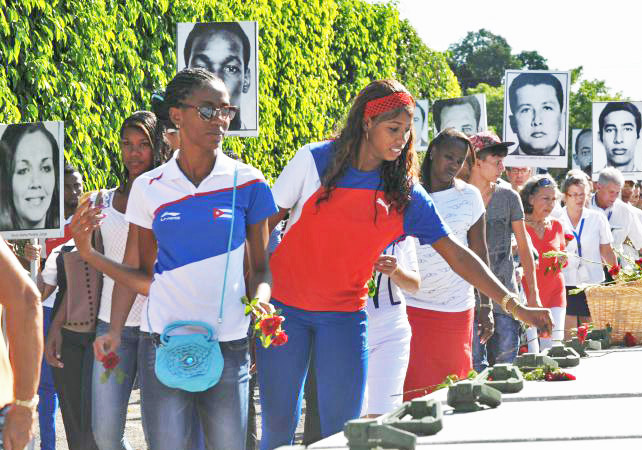“Cubana 455: Chronicles of October 6,” a three-part documentary and epilogue written and directed by Enrique Berumen
On Oct. 6, 1976, U.S.-backed enemies of Cuba’s socialist revolution detonated two bombs on Cubana airlines Flight 455. All 73 on board were killed, including the youthful Cuban fencing team, 11 people from Guyana and five from the Democratic People’s Republic of Korea.
The film explains how the bombing of Cubana 455 was one piece of a decadeslong campaign of terrorism and sabotage orchestrated by the White House, the State Department and the Central Intelligence Agency aimed at overturning the Cuban Revolution. It’s a powerful documentary.
It presents footage from the first days after the victory by revolutionary forces led by Fidel Castro that conquered power in 1959. It shows mobilizations of the Cuban people that were key to defeating the U.S.-backed invasion by Cuban counterrevolutionaries at the Bay of Pigs in 1961, and in defending their deepening socialist revolution.
From the outset the revolution’s leadership was marked by unstinting internationalism. By 1975, thousands of Cubans were volunteering to go to Angola at the request of the government there to join the fight to defend the country’s independence from former colonial ruler Portugal and to repulse an invasion by the U.S.-backed apartheid regime in South Africa. Successes in that struggle deepened Washington’s hostility toward the revolution, Castro explained, in a speech days after the downing of the plane.
Moving interviews with family members of those killed in the bombing are woven throughout the film. The fencing team, teenagers for the most part, had achieved international success. Involvement in sports of all kinds, from baseball to boxing to track and field, had mushroomed in Cuba after the revolution.
You see the plane takeoff from Barbados on its way to Jamaica and then Havana. You hear the air traffic controller and pilot exchanges. Then one bomb goes off. The pilot radios back that they are trying to return to the airport. Pandemonium. The plane circles back, nearly out of control. A second bomb explodes. The plane plunges into the ocean.
Nine days later, a million Cubans turned out at Havana’s Plaza of the Revolution to pay respects to the fallen and hear Castro explain why the Cuban people refused to be cowed by the atrocity.
The film shows Silvio Rodríguez, a popular Cuban singer, performing. “May injustice tremble when those who have nothing to lose cry out. The valiant people of Fidel,” Rodríguez sings.
A segment of the film contains interviews with counterrevolutionaries who masterminded scores of terror attacks against Cuba. Freddy Lugo and Hernán Ricardo were arrested hours after the bombing, convicted and spent 17 years in prison. They planted the bombs when they boarded the flight in Venezuela, leaving the plane in Barbados. After their arrest in Trinidad and Tobago they admitted to being paid to carry out the bombing by Luis Posada Carriles and Orlando Bosch, longtime leaders of Cuban counterrevolutionary forces.
The documentary shows Posada, Bosch and others offering their pretexts for the outrage with a coldblooded will to kill anyone connected to the revolution. You see the protection given them by every single U.S. administration, ensuring Posada Carriles and Bosch remained free for the rest of their lives.
The film ends with recent interviews with people in Havana. Some remember what happened on Oct. 6, 47 years ago, others don’t. But many remember what Castro said at the Oct. 15 rally, “When an energetic and forceful people cry, injustice trembles.”
Making the film was a 20-year project, producer Enrique Berumen García, told the Militant. It began after a visit to Cuba in 2001. Berumen is a retired professor at California State University at Los Angeles. In 2017 “the Cuban Institute of Cinematographic Art and Industry gave me access to their archives, which includes everything from Cuba’s revolutionary history and material they had on the Oct. 6 bombing,” he said.
Since its completion on July 26, 2022, Berumen has entered it in numerous film festivals. Thirteen have accepted the submission, but none, to date, in the U.S.
The film can be shown at community-based programs until the film festival circuit ends in April 2024. “Then I’m turning the film over to any TV station anywhere in the world that wants to show it,” he said.
I urge Militant readers to see it. Contact Enrique Berumen at docuCubana455@gmail.com to arrange a showing.


